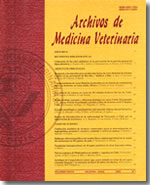Proteins of Porcine rubulavirus: Structure, function and pathological implications
Main Article Content
Abstract
Viral infections constitute serious concerns for breeders and veterinarians world wide, so the knowledge of the virus structure and biological properties is of primary importance in the design of prophylactic and control strategies to combat viral diseases. The Porcine rubulavirus (PoRV) is the causal agent of blue eye disease of swine, an endemic disease in Mexico, that is characterized by fatal meningoencephalitis in piglets and reproductive failures with loss of fertility in adult pigs. PoRV is an enveloped virus with a negative single stranded RNA genome belonging to the Paramyxoviridae family. This virus possesses six structural and three non-structural proteins. Structural proteins play an important role in the virus infectious cycle, promoting both virus dissemination and damage to infected tissues, while some non-structural proteins play a regulatory role, inducing viral persistence and preserving the tissues integrity to assure the survival of virus progeny. The objectives of this review are 1) to analyze the structure and function of paramyxoviral proteins and 2) to illustrate their role on the pathological features of PRV infection.

